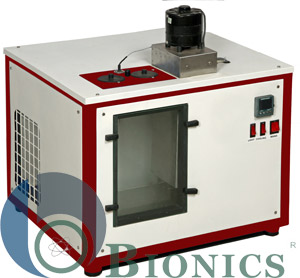A kinematic viscosity bath is a machinery widely used in laboratories by researchers and scientists to keep sustain accurate temperature for error-free viscosity Bath Testing. Industries such as petroleum, pharmaceuticals, chemicals, and manufacturing rely on viscosity baths to ensure consistent and repeatable results. However, some factors live in the environment that can highly affect the performance of these baths, and as a result, it can only cause problems and fluctuations in viscosity readings and compromise test accuracy.
This blog explores the key environmental influences on
kinematic viscosity baths and how to mitigate their effects for excellent
performance.
1. Temperature Fluctuations
Since kinematic viscosity is highly temperature-dependent,
even minor temperature fluctuations in the laboratory environment can affect
the bath’s ability to maintain stable conditions.
Effects on Kinematic Viscosity Bath:
·
Uncontrolled room temperatures may alter the
bath’s calibration, causing incorrect viscosity readings.
·
Sudden temperature shifts can increase heat loss,
requiring the bath to work harder to maintain stability.
·
Inadequate insulation or exposure to air
conditioning vents may create localized cooling or heating effects.
Solution:
·
Place the viscosity bath in a temperature-controlled
laboratory away from direct sunlight, ventilation ducts, or fluctuating heat
sources.
·
Use a double-walled insulated bath to minimize
external temperature interference.
·
Ensure the thermostatic control system is
regularly calibrated for precise temperature regulation.
2. Humidity & Moisture Infiltration
High humidity levels or condensation can cause moisture
buildup inside the viscosity bath, leading to contamination of the bath fluid
and inaccurate viscosity readings.
Effects on Kinematic Viscosity Bath:
·
Excess humidity can lead to water condensation
on sample holders and viscometers.
·
Moisture can mix with the bath liquid, altering
its thermal conductivity.
·
In extreme cases, prolonged humidity exposure
can cause corrosion of bath components.
Solution:
·
Maintain a humidity-controlled environment in
the laboratory.
·
Use sealed bath chambers to prevent external
moisture from entering.
·
Regularly check the bath fluid for signs of
contamination or degradation.
3. Air Pressure & Altitude Effects
Laboratories located at higher altitudes or areas with
fluctuating air pressure may experience changes in bath performance due to
differences in boiling points and fluid expansion.
Effects on Kinematic Viscosity Bath:
·
Reduced air pressure can cause higher
evaporation rates of the bath fluid.
·
Changes in atmospheric pressure may affect the
heating uniformity inside the bath.
·
At very high altitudes, boiling points of
liquids are lower, requiring adjustments in operating conditions.
Solution:
·
Use low-volatility bath fluids to minimize
evaporation.
·
If working in high-altitude conditions, adjust
the bath’s heating parameters accordingly.
·
Regularly check the bath fluid levels to
compensate for evaporation losses.
4. Contamination & Particulate Buildup
Dust, dirt, and other airborne contaminants can enter the
viscosity bath fluid, leading to inconsistent temperature regulation and
inaccurate viscosity readings.
Effects on Kinematic Viscosity Bath:
·
Contaminants settle at the bottom, interfering
with heat distribution.
·
Foreign particles can clog the viscometer tubes,
leading to inaccurate flow measurements.
·
Impurities may react with the bath fluid, reducing
its efficiency over time.
Solution:
·
Use a dust-free, clean environment to prevent
contamination.
·
Regularly filter and replace bath fluids to
remove particles.
·
Clean the bath chamber and internal components
periodically.
5. Evaporation & Fluid Degradation
Over time, viscosity bath fluids can evaporate or degrade,
affecting their thermal stability and ability to maintain precise temperatures.
Effects on Kinematic Viscosity Bath:
·
Evaporation leads to changes in bath fluid
levels, reducing heat transfer efficiency.
·
Thermal degradation can cause fluid breakdown,
affecting temperature stability.
·
Using an incorrect fluid type can lead to
overheating or poor viscosity control.
Solution:
·
Use high-boiling-point and thermally stable bath
fluids to minimize evaporation.
·
Keep the bath chamber covered when not in use to
reduce fluid loss.
·
Periodically check and replace degraded bath
fluids.
6. Electromagnetic Interference (EMI) & Electrical Disturbances
Electronic laboratory equipment, such as computers, motors,
and power sources, can cause electromagnetic interference (EMI), affecting the digital
controllers of the viscosity bath.
Effects on Kinematic Viscosity Bath:
·
EMI can cause erratic temperature readings on
the bath’s digital display.
·
Electrical fluctuations may lead to temperature
instability.
·
Power surges can damage sensitive electronic
components inside the bath.
Solution:
·
Position the viscosity bath away from high-EMI
equipment like transformers and power circuits.
·
Use a dedicated power source with a voltage
stabilizer to ensure consistent operation.
·
Ensure the bath’s electronic
components are shielded against interference.
Conclusion
Temperature inconsistency or instability, Dampness, air pressure, contamination, evaporation and electromagnetic interference are such Environmental factor that badly affects the accuracy to tests which significantly impact the performance of kinematic viscosity baths. Proper lab conditions, regular maintenance, and the use of high-quality
equipment ensure stable and reliable viscosity testing.
Bionics Scientific Technologies (P) Ltd., an ISO-certified
laboratory equipment manufacturer based in India, specializes in producing high-precision
kinematic viscosity baths with advanced temperature control, durable
construction, and user-friendly operation. With over 25 years of experience,
Bionics Scientific supplies customized lab solutions to research centers, oil
refineries, pharmaceutical companies, and government agencies worldwide.
By investing in a well-designed viscosity bath and following best practices, laboratories can achieve accurate viscosity measurements, ensure quality control, and maintain industry compliance.

Comments
Post a Comment